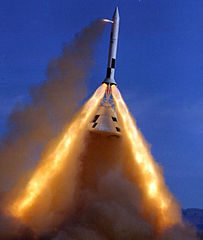Introduction to Rocket Science
Jun 15, 2015 21:49:07 GMT -5
Ater Nox, Baden-Wuerttemberg, and 2 more like this
Post by Byzesion on Jun 15, 2015 21:49:07 GMT -5
Before we begin, let me just make sure everyone's here. Baden-Wuerttemberg, Louisistan, Ater Nox, Flemingisa, Scottish and English Kingdom, Jin.
Welcome to the class, everybody. Now, since most of you have chosen to audit the class, I've decided to alter the curriculum a bit. All assignments and tests are now optional, but if you decide you want to try them, you'll be given credit for it. I know it's kind of an intimidating subject, but I'll do my best to make it accessible without dumbing it down.
Before we get into rocketry, we have to cover the basics of aerodynamics. There are four basic forces that act on a craft in flight: lift, thrust, weight and drag. In order, lift is pressure on the surface of the craft pushing it upwards; thrust is the force, usually derived from engines, that propels the craft forward; weight is just that: the mass of the craft multiplied by gravity, which acts to counter the lift force; and drag is the air pressure at the front of the craft acting against the thrust.
Now, lift is one of the trickier forces to explain. It's usually represented something like this:

However, this explanation is oversimplified to the point of being incorrect. The actual explanation does involve pressure, but not the speed of the air. In fact, it's more about the angle of attack of the wing, which is the angle up or down the nose of the airfoil is meeting the air. Put plainly, rather than slow moving air creating the pressure, an airfoil that's pitched upwards compresses the air under it, which then pushes it upward. Naturally, it's more complicated than just that, but this explanation will do for our purposes.
Thrust is much simpler, and can be most easily understood as Newton's Third Law of Motion ("A body, acted on by a force will react with an equal and opposite force"), applied. A propeller pulls air over the wings, and pusher propellers, jet engines, and rocket engines push the craft forward. In a propeller-driven craft, an internal combustion engine or (usually in model aircraft) electric motor turns a shaft, at the end of which a propeller pushes or pulls the air, similar to how an airfoil generates lift. In jet and rocket engines, a mixture of fuel and an oxidizer (compressed air in a jet engine, liquid oxygen in most large rockets and occasionally concentrated peroxide in some of the larger amateur rockets) is burned and the exhaust through a nozzle creates the thrust.
[Note: The rest will be completed in the near future, as I am literally so furious about the Lightning-Blackhawks game that I can't think straight.]
Welcome to the class, everybody. Now, since most of you have chosen to audit the class, I've decided to alter the curriculum a bit. All assignments and tests are now optional, but if you decide you want to try them, you'll be given credit for it. I know it's kind of an intimidating subject, but I'll do my best to make it accessible without dumbing it down.
Before we get into rocketry, we have to cover the basics of aerodynamics. There are four basic forces that act on a craft in flight: lift, thrust, weight and drag. In order, lift is pressure on the surface of the craft pushing it upwards; thrust is the force, usually derived from engines, that propels the craft forward; weight is just that: the mass of the craft multiplied by gravity, which acts to counter the lift force; and drag is the air pressure at the front of the craft acting against the thrust.
Now, lift is one of the trickier forces to explain. It's usually represented something like this:

However, this explanation is oversimplified to the point of being incorrect. The actual explanation does involve pressure, but not the speed of the air. In fact, it's more about the angle of attack of the wing, which is the angle up or down the nose of the airfoil is meeting the air. Put plainly, rather than slow moving air creating the pressure, an airfoil that's pitched upwards compresses the air under it, which then pushes it upward. Naturally, it's more complicated than just that, but this explanation will do for our purposes.
Thrust is much simpler, and can be most easily understood as Newton's Third Law of Motion ("A body, acted on by a force will react with an equal and opposite force"), applied. A propeller pulls air over the wings, and pusher propellers, jet engines, and rocket engines push the craft forward. In a propeller-driven craft, an internal combustion engine or (usually in model aircraft) electric motor turns a shaft, at the end of which a propeller pushes or pulls the air, similar to how an airfoil generates lift. In jet and rocket engines, a mixture of fuel and an oxidizer (compressed air in a jet engine, liquid oxygen in most large rockets and occasionally concentrated peroxide in some of the larger amateur rockets) is burned and the exhaust through a nozzle creates the thrust.
[Note: The rest will be completed in the near future, as I am literally so furious about the Lightning-Blackhawks game that I can't think straight.]





















